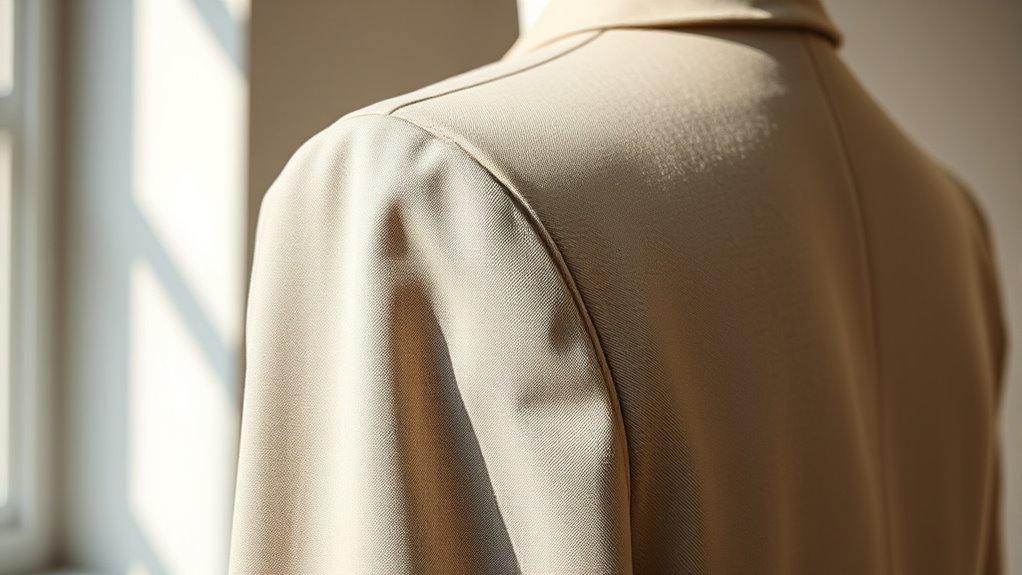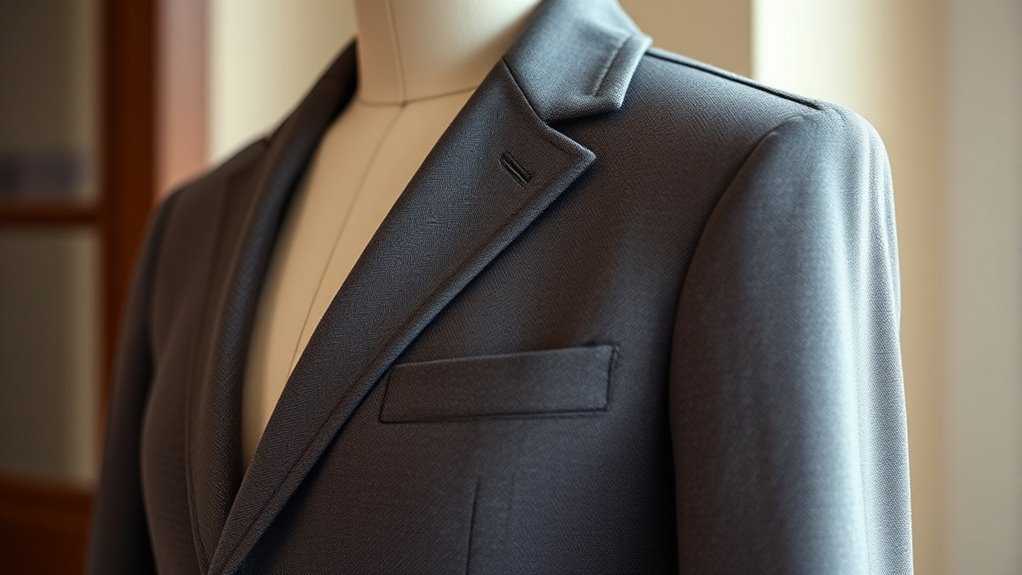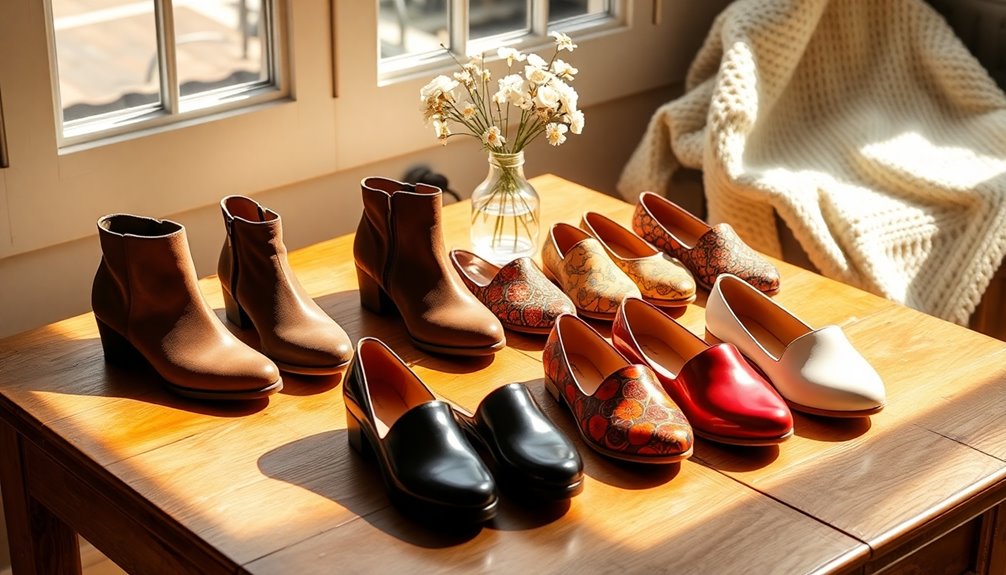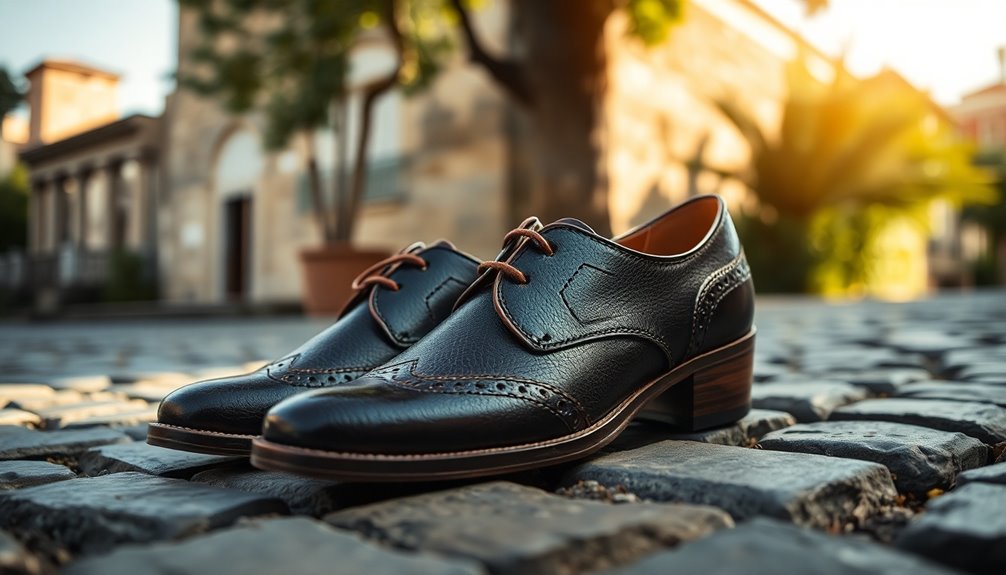Understanding fit means paying attention to how your shoulders, rise, and break work together for a polished look. Guarantee your shoulder seams sit perfectly at your shoulders for proper structure. Choose a rise that matches your body; high for lengthening, low for comfort. The break, or fold where pants meet your shoes, should be neat and intentional. Mastering these details helps you craft a balanced, confident style—if you keep exploring, you’ll discover even more tips to perfect your fit.
Key Takeaways
- Proper shoulder fit aligns the seam exactly at the shoulder end for a sharp, comfortable look.
- The rise determines how the waistband sits, affecting comfort and the overall silhouette.
- The break shows how pants meet shoes; a slight break looks neat, while excessive bunching indicates poor fit.
- Fabric textures influence how garments drape and how well they hold their shape around shoulders and rise.
- Combining correct shoulder alignment, rise, and break creates a polished, flattering, and comfortable outfit.

Have you ever wondered what makes clothing truly feel right? It’s not just about the size, but how the fabric textures and color matching come together with fit to create a look that feels effortless and comfortable. When you’re trying to find that perfect fit, understanding how shoulders, rise, and break work can transform your wardrobe choices. These elements determine how your clothes sit on your body and how confident you feel wearing them.
First, let’s talk about shoulders. This area is essential because it sets the foundation for the entire garment’s fit. When your shirt or jacket fits well across the shoulders, it aligns with your natural shoulder line, preventing fabric from bunching or pulling. Fabric textures play a role here: smoother, more structured textures like twill or suiting fabrics tend to hold shape better, emphasizing a clean shoulder line. Softer, more elastic textures like jersey or knits can provide more flexibility, but they might also cause the garment to sag if they aren’t tailored properly. When you pay attention to how the shoulders fit, you’ll notice that the seam sits exactly where your shoulder ends, without drooping or riding up. Achieving this balance makes your overall look sharp and enhances your comfort.
Next, consider the rise—the distance from your crotch to the waistband in pants or the length from the waist to the bottom in skirts and dresses. The rise affects how your clothing fits around your waist and hips, influencing your silhouette. A proper rise ensures the garment sits comfortably without digging in or sagging. When choosing pants, think about your body shape and how the rise aligns with your natural waist. For example, high-rise styles elongate your legs and create a smooth line, while lower rises can sit more comfortably on different body types. Color matching also plays a role here, especially when pairing tops and bottoms—your clothing should complement each other in tone and shade, creating a cohesive look that emphasizes your best features. Fabrics with different textures can affect how the rise feels; a stiffer fabric might hold the shape better, while softer materials drape more loosely. Additionally, understanding bad fitting helps you recognize which styles and textures are most flattering for your body type.
Finally, understanding the break—the fold or crease that forms where your pants meet your shoes—is vital for a polished appearance. A slight break looks neat and intentional, while too much fabric bunching indicates a poor fit. The break’s size can be influenced by fabric textures, as stiffer fabrics tend to create a sharper break, and softer, more fluid fabrics produce a more relaxed look. Proper color matching between your shoes, belt, and pants can tie your entire outfit together, making even minor details like the break appear intentional and stylish.
Getting fit right involves paying attention to these details—shoulders, rise, and break—and understanding how fabric textures and color matching influence the overall look. When you combine good fit with the right textiles and hues, you’ll always look sharp, feel comfortable, and project confidence effortlessly.
Frequently Asked Questions
How Do Shoulder Measurements Affect Overall Fit?
Your shoulder measurements, including shoulder width and armhole size, directly impact how well a shirt fits. If your shoulders are broader, a garment with narrow shoulder width will feel tight and restrict movement. Conversely, overly wide shoulders create excess fabric that looks sloppy. Ensuring the shoulder width aligns with your measurements helps the garment sit properly, while the armhole size affects comfort and mobility. Proper fit enhances your overall appearance and confidence.
What Is the Ideal Rise for Different Body Types?
The ideal rise varies by body type; for example, taller individuals benefit from a longer rise, while shorter frames prefer a shorter one. When choosing, consider pocket placement and fabric stretch, as these influence comfort and fit. A higher rise offers more coverage and a stylish break, but make certain the fabric has enough stretch to move with you. Try different rises to find what feels most natural and flattering for your body shape.
How Can I Tell if a Break Suits My Style?
Think of your personal style as a well-tailored map; a break that suits you feels like a natural bend. To tell if it fits, look at how the break complements your fabric choice and overall silhouette. If it adds character without overwhelming, it’s right for you. A good break should enhance your look, reflecting your unique style, not just follow trends. Trust your eye and feel confident in your choice.
Do Fit Considerations Vary Across Clothing Brands?
Yes, fit considerations vary across clothing brands due to differences in brand consistency and sizing standardization. You might find that a medium in one brand fits like a small in another, so it’s crucial to check each brand’s sizing chart and read reviews. Always try on clothes when possible, and don’t assume size equivalency—what fits well in one brand might not in another.
How Often Should I Reassess My Clothing Fit?
You should reevaluate your clothing fit every 6 to 12 months, as style evolution and seasonal adjustments can change your body shape and preferences. Did you know that 65% of people find their clothes feel different after just a few months? Regularly checking your fit guarantees comfort and style. Try on your favorite pieces periodically, especially after weight changes or seasonal shifts, to maintain a polished, confident look.
Conclusion
Now that you understand the importance of shoulders, rise, and break in fit, you’ll make smarter clothing choices. Did you know that 70% of people feel more confident when their clothes fit perfectly? Remember, a well-fitting shirt or jacket not only looks better but also boosts your comfort and confidence. Pay attention to these details the next time you shop, and you’ll always leave with clothes that truly fit you.










